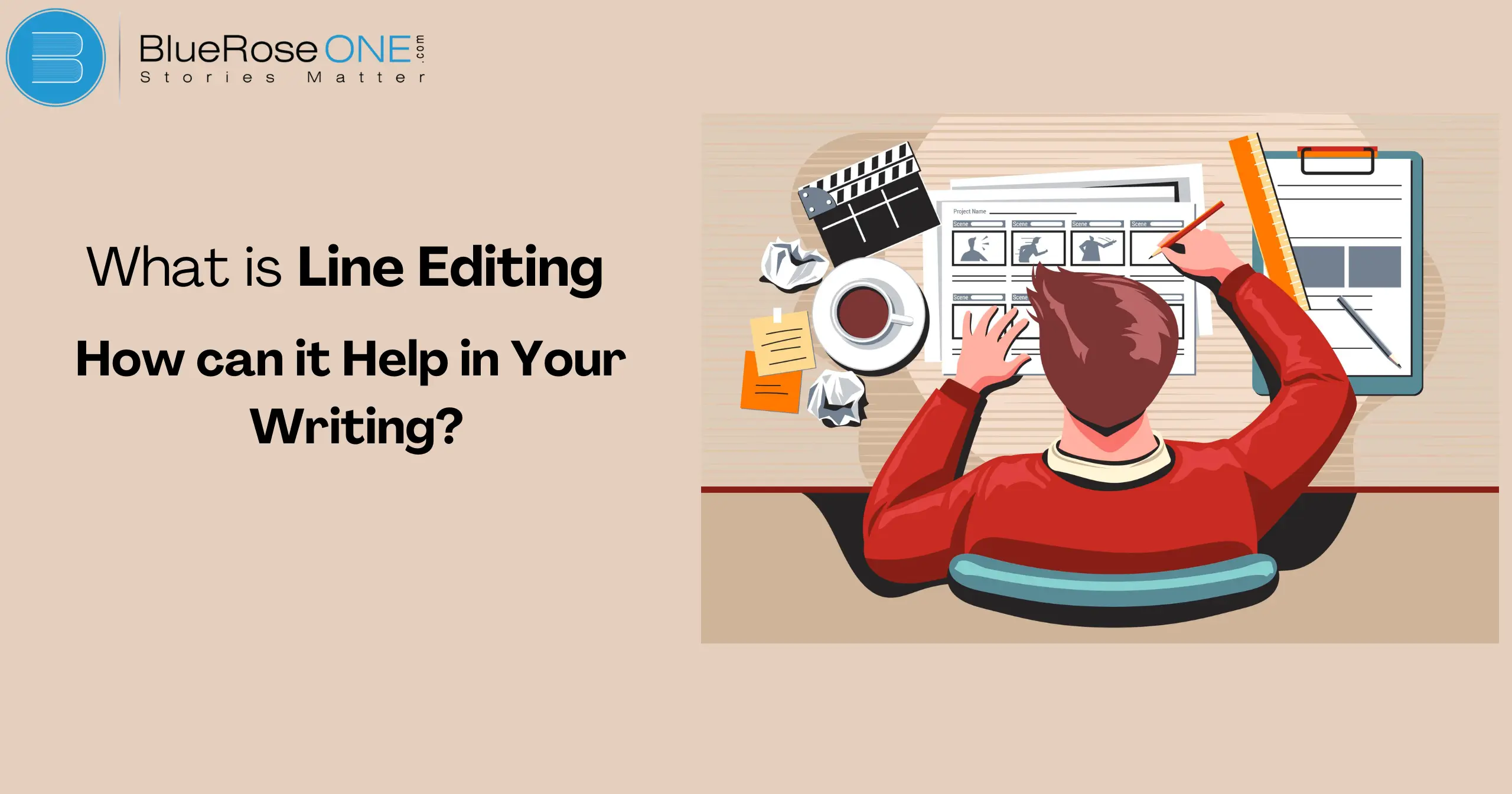Writing is a craft that needs to be polished and refined much like any other craft. Line editing is one of the most important phases in the writing process.
However, what exactly is line editing, and how can it help you write better? We’ll explore the nuances of line editing, its advantages, and how it can help you write better in this post.
What is Line Editing?
Editing that concentrates on the language, style, and content of your text is called line editing. Line editing focuses on the way you communicate your thoughts, as opposed to developmental editing, which takes a broad approach, or copy editing, which concentrates on technical accuracy. It entails going over each line of text to enhance impact, flow, and clarity.
The Goals of Line Editing
The primary goals of line editing are:
Clarity
Improving writing clarity is one of the main objectives of line editing. When you explain your thoughts clearly, your readers will be able to understand you and your points of view.
Sentences are polished during line editing to remove any unclear wording, inappropriate phraseology, or complex sentence structures. This includes fixing typographical problems, selecting exact wording, and making sure that each sentence builds on the one before it.
Line editing helps you write more coherently and easily so that your message may be understood clearly and concisely. It does this by emphasizing clarity.
Flow
Enhancing the writing’s flow is one of the primary objectives of line editing. The seamless and logical transition from one thought to the next in your writing is referred to as flow.
Good line editing makes your work more readable and interesting by ensuring that your sentences and paragraphs make sense. Line editing helps get rid of uncomfortable phrasing and duplication by concentrating on phrase structure, word choice, and transitions.
This procedure improves clarity and sustains readers’ interest, which makes your work more captivating and pleasurable.
Style
The goal of line editing is to make your work more readable, interesting, and consistent. This procedure entails going over the text’s overall flow, phrase construction, and word choice.
Line editing improves the readability and appeal of your work by fixing bad phrasing, redundant language, and clumsy sentences.
Additionally, it guarantees that your distinct voice is heard while keeping a formal tone. In summary, line editing makes your writing smoother, more engaging, and more enjoyable for readers by transforming it from raw and unpolished to polished and compelling.
You may also read: How to Outline a Memoir in 6 Steps
Benefits of Line Editing
Line editing offers numerous benefits:
Enhancing Readability
Among the main advantages of line editing is improved readability. A line editor works to improve your writing’s clarity and flow by making little changes to your sentence structure, word choice, and general style.
This procedure makes sure that your concepts are communicated effectively and concisely, which facilitates readers’ comprehension of what you’re trying to say.
Additionally, line editing aids in the removal of inappropriate phrasing and repetition, which can confuse and divert readers. Line editing polishes your writing to improve readability, which draws readers in and increases the enjoyment of your work.
Improving Tone and Style
The goal of line editing is to make your writing more coherent, readable, and consistent by honing its tone and style. Line editing makes your writing flow better and connect with readers by fixing problems like awkward phrasing, repetitive vocabulary, and inconsistent tone.
It polishes your word choice and sentence construction, improving readability and boosting the impact of your message. Effective line editing will improve the readability of your work by helping you express your points clearly and consistently retain the intended tone.
Ensuring Consistency
To maintain consistency in your work, line editing is crucial. This procedure entails ensuring that your writing flows naturally and coherently by examining for consistency in voice, tone, and style.
Maintaining the reader’s interest and comprehension requires consistent usage of vocabulary, tense, and point of view. Line editing improves the readability and clarity of your writing by paying attention to these little details, which helps to avoid confusion and raises the standard of your work overall. To put it briefly, line editing is an essential step in creating polished, expert writing that appeals to your readers.
Reducing Errors
Eliminating errors from your work is one of line editing’s main advantages. Correcting spelling, grammar, and punctuation errors is the main goal of line editing.
This focus on detail guarantees that your work is credible and competent while also facilitating a more enjoyable reading experience. Line editing improves readability and clarity by identifying and repairing these mistakes.
Eliminating awkward phrasing and inconsistencies also helps to improve the readability of your writing. All things considered, line editing is crucial to creating excellent, error-free material.
You may also read: Magical Realism 101: How to Write Magical Realism in Your Own Stories
The Line Editing Process
The line editing process typically involves three main steps:
Initial Read-Through
Eliminating inaccuracies in your work is a significant advantage of line editing. The goal of line editing is to improve your writing by fixing typos, punctuation, and grammar.
This focus on detail makes your writing more readable and guarantees that it is credible and competent. Line editing improves the readability and clarity of your work by identifying and correcting these problems.
Additionally, it makes your writing more readable by getting rid of difficult language and inconsistencies. In general, line editing is necessary to create flawless, high-quality text.
Detailed Line-by-Line Analysis
The process of line editing is a painstaking, in-depth examination of your content line by line, greatly improving its impact and clarity. Line editing helps you polish your writing and make sure that your thoughts are communicated succinctly by paying close attention to each sentence.
Grammar mistakes, strange wording, and inconsistencies that could normally go overlooked are caught by this method. Additionally, line editing enhances your text’s readability and flow, drawing readers in and increasing its engagement. In the end, this meticulous examination improves the general caliber of your writing, giving it a more polished and polished appearance.
Final Review
To make sure your writing is polished and businesslike, line editing is an essential last check for your book. This method enhances style, clarity, and sentence structure above and beyond simple proofreading.
A line editor will find poor phrasing, redundant language, and consistency issues by carefully going over each line, which will improve the readability and interest of your work.
This degree of examination aids in honing your distinctive voice and guarantees that your point is communicated clearly. In the end, line editing improves your writing’s overall quality, drawing readers in and increasing their enjoyment.
Key Elements of Line Editing
Line editing focuses on several key elements:
Grammar and Syntax
Grammar and syntax are essential for polishing your writing when it comes to line editing. Grammar is the set of rules that control how sentences are put together, how punctuation is used, and how verb tenses are consistently used in sentences. Writing with proper grammar guarantees professionalism and clarity.
Contrarily, syntax focuses with how words are arranged in sentences to provide effect and meaning. A proficient line editor concentrates on these components to improve the text’s readability and flow, ensuring that each sentence is understandable, succinct, and successfully conveys your ideas to the reader. Through line editing, these adjustments are essential to producing polished and expert writing.
Word Choice
Grammar and syntax are very important when it comes to line editing because they help you write better. The rules guiding sentence construction, verb tense consistency, and appropriate punctuation are all considered to be parts of grammar.
Proper grammar guarantees professionalism and clarity in your writing. Contrarily, syntax deals with word choice and sentence construction to produce impact and meaning.
A competent line editor pays close attention to these details to improve the text’s readability and flow, ensuring that each sentence expresses your ideas to the reader in an understandable, succinct manner. By line editing, polished and professional writing can be achieved with these refinements.
Sentence Structure
Sentence structure is essential for improving writing flow and clarity when it comes to line editing. It focuses on sentence construction, making sure phrases are understandable, succinct, and interesting.
Line editing efficiently highlights important ideas and keeps readers interested by experimenting with phrase lengths and styles.
In order to guarantee that every sentence flows naturally into the larger story or argument of your work, this method also takes care of grammar and syntactic problems. In line editing, a well-constructed sentence is crucial to delivering ideas clearly and powerfully.
Pacing
In line editing, pacing is the rhythm and speed at which a tale develops; it is essential to keeping readers interested. It entails controlling the paragraph and sentence flows to determine how swiftly or slowly readers go through the story.
Whether the writing is meant to be a quiet meditation or a fast-paced action piece, effective line editing makes sure that the pacing stays true to these elements.
Line editing improves your writing’s overall effect and readability by rearranging paragraph length, phrase structure, and detail placement to make it more engaging and pleasurable for your readers.
You may also like like: How to Become an Author in 2024: An Essential Guide for Beginners
Line Editing vs. Copy Editing
While line editing and copy editing are often confused, they serve different purposes:
Line Editing: Line editing focuses on enhancing the clarity, coherence, and effectiveness of your writing at a deeper level than copy editing. It involves refining sentence structure, improving word choice, and ensuring the flow of ideas is smooth and logical.
Line editing aims to strengthen the overall narrative or argument by addressing issues such as awkward phrasing, repetition, or ambiguity. This process is crucial for authors seeking to elevate their manuscript’s quality and readability, making it more engaging and impactful for readers.
Copy Editing: Copy editing is an important part of writing and is frequently used in conjunction with line editing. Copy editing zooms in on the finer details while line editing concentrates on improving your manuscript’s narrative flow, style, and coherence.
It carefully fixes spelling, grammar, and punctuation mistakes while guaranteeing that the layout and language usage are consistent across the document. This procedure guarantees coherence and clarity, polishing your work and preparing it for publication. It also improves the readability and professionalism of your writing.
Knowing when to use each type is essential for producing a polished manuscript.
How to Line Edit Your Own Work
Editing your own work can be challenging, but these steps can help:
Take a Break: It’s important to give yourself time to relax after finishing your draft before beginning the line editing process. This mental break gives you the opportunity to focus on your work with a new perspective.
You will be better able to spot awkward language, repeating words, and other problems that need to be fixed if you take a day or two off from writing. In order to ensure that your writing is clear and polished, this break is an essential part of the line editing process.
Read aloud: One of the best line editing techniques is to read your work out loud. Hearing what you say makes it easier to identify run-on phrases, repeating words, and bad wording.
It also draws attention to places when the dialogue sounds strange or the flow is awkward. This method makes your writing fluid and interesting, which improves the effectiveness of your line editing process and produces a polished, reader-friendly final draft.
Focus on One Element at a Time: To ensure clarity and thoroughness during line editing, it is imperative to concentrate on one aspect at a time. Grammar and punctuation should be reviewed first, followed by sentence structure and word choice.
You can more successfully detect and fix problems by addressing each component independently, which will produce a polished and expert piece of writing. This meticulous approach to line editing raises the standard of your work as a whole.
You may also like: What is an Anti-Villain? Definition, Tips, and Examples
Hiring a Professional Line Editor
Sometimes, hiring a professional is the best option:
When to Consider: Take into consideration how polished your article must be before publishing when thinking about hiring a professional line editor. If you want to improve the clarity, tone, and refinement of your writing, line editing is a must.
It’s especially helpful if you think your tale is compelling but your language may use some work. A line editor can help your writing shine if grammar, syntax, and flow are issues, enabling you to submit the best version of your work.
Choosing the Right Editor: For line editing, selecting the proper editor is essential to making your manuscript better. Seek for someone who pays close attention to detail and has a proven track record in your genre.
A competent line editor improves clarity and flow in addition to fixing grammar and punctuation. Verify their references and request a sample edit to make sure their work fits your aesthetic. Your writing can be transformed by the proper editor, becoming more polished and interesting.
Tools and Resources for Line Editing
Several tools and resources can assist with line editing:
Software and Apps: Apps and software can be very beneficial when it comes to line editing. Grammar checkers, correction suggestions, and readability enhancers are some of the capabilities provided by programmes such as Grammarly, ProWritingAid, and Hemingway Editor.
Instant response from these apps saves time and makes them easy to use. These tools allow writers to concentrate on honing their style and making sure everything is clear, which improves the effectiveness and efficiency of the line editing process.
Books and Guides: Books and guides online editing are invaluable resources for writers. They provide detailed instructions and examples on how to refine prose for clarity, style, and flow. Popular titles include The Chicago Manual of Style and Self-Editing for Fiction Writers by Renni Browne and Dave King.
These guides offer practical tips on sentence structure, word choice, and punctuation, helping writers enhance their work and master the art of line editing.
You may also like: Anti Hero vs. Traditional Hero: What’s the Difference?
Examples of Line Editing
To understand the impact of line editing, consider these before and after examples:
- Before: “She walked quickly to the store to buy some milk.”
- After: “She hurried to the store to grab some milk.”
Conclusion
A vital phase in the writing process that can greatly improve the caliber of your work is line editing. Line editing contributes to the creation of a polished and professional document by concentrating on clarity, flow, style, and consistency. The advantages of line editing are evident, regardless of whether you edit your own work or get it professionally done.
















